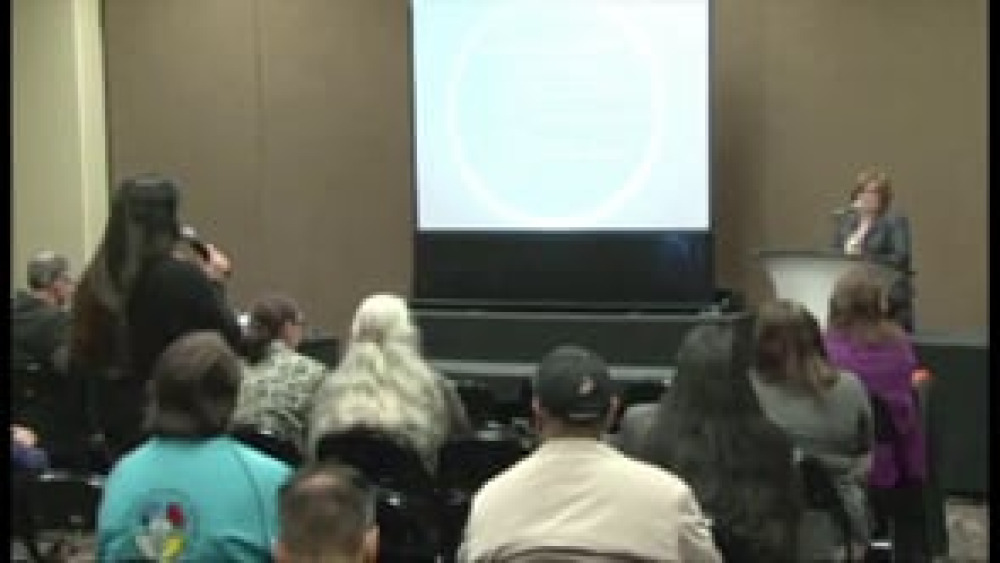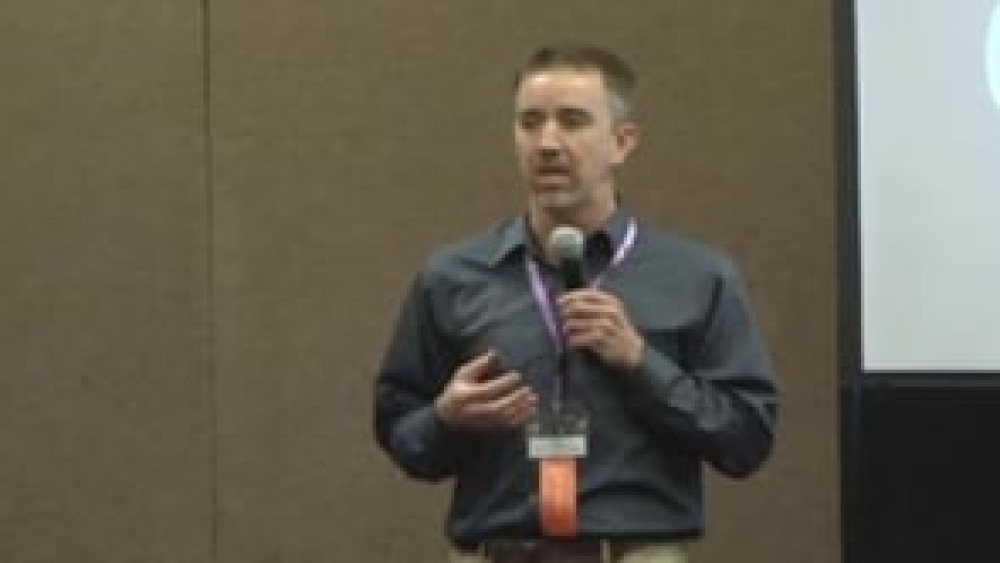Co-director of the Harvard Project on American Indian Economic Development Stephen Cornell offers a review of how the Honoring Nations program evolved out of the nation-building movement and successes among Native nations.
Additional Information
Cornell, Stephen. "Achieving Good Governance: Lessons from the Harvard Project & Honoring Nations." Honoring Nations symposium. Harvard Project on American Indian Economic Development, John F. Kennedy School of Government, Harvard University. Sante Fe, New Mexico. February 8, 2002. Presentation.
Transcript
Andrew Lee:
"Now I'd like to turn the microphone over to Professor Steve Cornell, the co-founder of the Harvard Project and the current Director of the Udall Center for Studies in Public Policy at the University of Arizona. And the talk that he's going to talk about is 'Achieving Good Governance: Lessons from the Harvard Project and the Honoring Nations Awards Program."
Stephen Cornell:
"Thank you very much, Andrew. It's really a great pleasure to be here and to join Chief [Oren] Lyons and the other members of the board of the Honoring Nations Program, to join all of you who have come to attend this symposium, and in particular to be here with representatives of these award-winning programs. I have to tell you that when Joe Kalt and I started the Harvard Project 15 years ago, we had no idea of where it was going to lead. And I find myself astonished and humbled and thrilled by what has developed over the years, thanks to the efforts of an enormous number of people from what, in our own minds, I think, were very modest beginnings.
We're here this morning to talk about good governance in Indian Country and to hear from Indian nations who are making government work. Before we get very deeply into that we thought it would be useful to review how we got here. Where did this program come from? In fact, why even have a program called 'Honoring Contributions in the Governance of American Indian Nations'? My job this morning is to say something about why good governance is something that should be honored and achieved in Indian Country and in doing so, to tell you something about the origins of this program. So I want you to...I want to take you back 15 years to Harvard University in the mid-1980s. A couple of nerd academics, Joe Kalt and me, are sitting around puzzling over something.
If you looked around Indian Country in the 1980s, one of the things that would have struck you rather powerfully is this. For whatever reason, some Indigenous nations in this country were doing much better than others economically. For example, on the one hand, you had Cochiti Pueblo with an unemployment rate between 10 and 20 percent in late 1980s. On the other hand, you have the Pine Ridge Sioux Reservation in South Dakota with Oglala Sioux Tribe at unemployment rates probably over 90 percent unemployment. On the one hand you have the Crow Tribe of Montana rolling in natural resources -- from coal to grazing to water to timber -- but locked in poverty, unable to turn all that wealth of material into viable tribal enterprises and to improve the welfare for their people. And on the other hand, you have the White Mountain Apache Tribe in Arizona that was running the most productive saw mill -- Indian or non-Indian -- in the western United States, a profitable commercial hunting operation, a profitable skiing operation and assorted other tribal enterprises. On the one hand, you have the Northern Cheyenne Tribe with an economy generating almost no dollars at all other than those that came in through federal transfer payments, just about the ultimate in economic dependency. And on the other hand you have the Mississippi Band of Choctaw Indians, who were starting to import non-Indian labor because they were creating so many jobs there weren't enough Choctaws to fill them. So you have black and white workers driving onto Choctaw lands every day to take jobs in Choctaw-owned and -operated enterprises.
We could give you other examples, which offer stark differences between on the one hand, nations often characterized by deep poverty, frustration, hopelessness, on the other hand, nations that were seizing control of their future, were building sustainable economies, were reshaping their futures to meet their own designs. And bear in mind, this is before the impact of gaming. We weren't yet seeing what that was going to do in Indian Country. These were enterprises that had nothing to do with that. These were nations, which in a very difficult time were in essence saying, 'We're going to reshape the future to meet our designs,' and they were doing it. What was it we wondered that determined which path any given nation took? Why does one nation move forward, another seems to run in place or slip backward? How would we account for these differences? And the Harvard Project on American Indian Economic Development was born out of those questions.
We approached Norm Collins at the Ford Foundation and told him we wanted to try to find out the answers to these questions, not just because we were inquisitive nerd academics -- sure, we found these questions kind of interesting -- but because we were convinced that the answers to these kinds of questions might be useful to all of Indian Country and maybe beyond Indian Country. Maybe Indian Country was doing things that the rest of the world ought to be paying attention to, because the real question lying behind all of this has to do with the keys to successful nations, nations that control their own affairs, improve the welfare of their people and take care of the things that they most value in their lives. Well, Norm Collins agreed and the major work of the Harvard Project got under way.
What did we do over the next few years? Accumulating colleagues, Manley Begay who joined us first and is still here and now direct the Native Nations Institute at the University of Arizona, and eventually a host of others. We went around talking to Indian nations trying to understand what were they doing, what was working, why was it working, what could we learn from it, what could other nations learn from what was happening in Indian Country? Now of course we weren't the first ones to ask this question. The basic question was why? Why are some doing better than others? There were other answers out there. A lot of people thought they knew why. Nations with lots of natural resources would be doing better than those without. Nations with good education would be doing better than those without. Geographic location would matter, capital would matter, etc. As we talked to people and we began to look at this data, it turned out that while some of these things were important -- sure, you'd rather have good resources than not and good education than not -- and in fact, they didn't do a very good job of explaining the pattern of development that we saw out there.
We saw tribes with great natural resources and high education that were doing poorly. We saw tribes such as Mississippi Choctaw with no significant natural resources to speak of and below average education for Indian Country that were doing wonderfully well. We saw tribes with strong leaders who were in trouble and tribes where the leadership turned over every year like Cochiti Pueblo who were doing very well indeed. So it was clear that these things helped. It was also clear that they weren't the keys to economic development. They didn't in and of themselves lead to sustainable, self-determined economic development in Indian Country. So what did those keys turn out to be? I'm going to point to five of them that emerged from our research. In some ways this has become what my colleague Joe Kalt describes as the Harvard Project mantra.
The keys to economic development in Indian country, based on 15 years now of work with Indian nations. First, sovereignty matters. Indian nations have to be in the driver's seat if we're going to see sustainable community and economic development in Indian Country. Why do they have to be in the driver's seat? It puts the economic development and community development agenda in Indian hands. It links decisions and their consequences -- those who are making the decisions reap the benefits of those decisions and pay the price when they make bad decisions. We cannot find a case in all these years of sustained economic development in Indian Country where someone other than the Indigenous nation is calling the shots, determining how resources are used, determining strategic direction, shaping the internal affairs of the nation, controlling its relationships with other governments. If you think about that, it's got a pretty potent policy message. In a century of federal efforts to end reservation poverty, it turns out that self-determination is the only federal policy to have a sustained impact in Indian Country, a sustained impact on poverty. The evidence from our research is tribal sovereignty is the only anti-poverty program that works. That's a very positive thing to say from the view of Indian Country but it's based on research. We can show you the data.
Second though, it turns out sovereignty isn't the only thing that matters. Being in the driver's seat isn't enough to create sustainable, self-determined, economic development. You've got to be able to get where you want to go. What does this include? It includes basic issues and concepts of good government. It means stability in government. Not stability in the people who are governing, stability in the rules by which they govern. It means getting politics out of business management. It means having courts or other dispute resolution mechanisms that are depoliticized where how you're treated doesn't depend on who you are, who your relatives are, who you voted for and so forth. It means having a bureaucracy that can get things done. What happens when you do these things? You create an environment in which individuals, tribal members, and others want to invest time, energy, ideas, money, their talent. What this does is it pulls in talent; it reduces the brain drain. It encourages young people to stay and others to come home. It focuses your human resources not on fighting over the pie, the economic pie, but in making it bigger and on designing it to meet the real needs of the people.
So the first two keys were sovereignty and good governing institutions. The third key we came up with, culture matters. It turns out that the most successful governing institutions that we see across Indian Country have found ways to work with Indigenous conceptions of how authority ought to be organized and exercised. They don't just pull institutions off the shelf that someone else invented or that the federal government came up and said, 'Here's what you need to govern yourselves.' They looked to their own traditions and retooled those traditions to meet the current contemporary demands and in doing so made those institutions win the support of their people. It's no accident that two of the most successful tribes in the group that we've worked with and studied have radically different governing institutions. Cochiti Pueblo where the spiritual leaders are the ultimate authority in the tribe and Confederated Salish and Kootenai Tribes of the Flathead Reservation whose governing institutions look like they came out of my high school civics textbook. They're both wonderfully successful because they found institutions that are their institutions that resonate with their people.
Fourth, it turns out a strategic orientation matters. We all know how tough it is to govern in Indian Country, the pressures on tribal leadership, the crises that come up, the obstacles thrown in your path by the federal government and others. But that strategy that is just band-aids and firefighting and opportunism turns out to be far less effective than a long-term strategy that asks what kind of society are we trying to build, what is it we're trying to protect, what are we trying to change, what do we want to preserve and then makes contemporary immediate decisions in the context of those ideas.
And finally, yes, turns out, leadership matters. But it's not just a question of picking the right men or women to fill particular positions in government. It's really about finding those individuals or groups who are willing to take responsibility for the future of the nation, who are willing to break with established ways of doing things, have a vision for the future, understand what kind of change is necessary to realize that vision. And what we found is that that kind of leadership can be found in all kinds of places, not just among elected officials. You might find it in one village. You might find it happening in your schools. You might find it happening in an enterprise, in a program, on the council. Leadership it turns out has more to do with what you do than with what position you're in.
So what did we conclude? Other assets are helpful but when Indian nations are in the driver's seat, when they effective and culturally appropriate governing institutions, when they make decisions for the long run, when they have leadership that is less interested in distributing goodies than in rebuilding the nation, then other assets, the things we started out wondering what part they played, then those assets begin to pay off. In other words -- and Andrew already said this -- successful Indian nations assert their sovereign powers, build effective governing institutions that match their cultures, identify strategic objectives, and support the leadership that is willing and able to get them there.
Those are the lessons of the Harvard Project and the objectives of the Honoring Nation program really reflect those findings. Its purpose is to identify, recognize and celebrate examples of good governance in Indian Country. That's why the program's not called 'Honoring Contributions in Social Programs' or 'Honoring Contributions in Economic Development' or 'Honoring Contributions in Education' or something like that, although we find ourselves repeatedly honoring exactly those things. It's called 'Honoring Contributions in the Governance of American Indian Nations' because it is in part in their capacity to act as nations, to assert their sovereign powers, to exercise that sovereignty effectively, to build an environment that can persuade talented, energetic, resourceful tribal members and non-members to bet on the tribal future, to bet on it here and not there. In other words, it's in their capacity to govern well that Indian nations like other nations around the world can best shape their own futures according to their own designs.
I think today you're going to hear from and about many of the Honoring Nations awardees and you'll see in their stories most of these themes because the award-winning programs are themselves examples of tribal sovereignty in action, of Indian nations that are tackling difficult problems in their own ways, are building institutions and tribal programs that can deal with those problems effective, are drawing on their own cultures as they do so, weaving their own values and views into their solutions and initiatives, thinking for the long run, rebuilding nations that work, nations that will last, and of course these award-winning programs are themselves examples of leadership. These are Indigenous initiatives that in a difficult time and as Chief Lyons said, 'We're in a difficult time,' offer enormous promise not only to their own nations but to all of us.
The big lesson of the Honoring Nations program is that tribal government works. We see a wave of innovation rolling across Indian Country. It's an innovation that draws on the past, responds to the challenges of the present, is building a much better and stronger future for Indian nations. It has worked and lessons to teach us all, and again we honor those programs for what you're doing and for what you offer to us."



